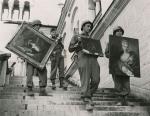
Expert Centre Restitution
Investigating individual applications for restitution
The ECR conducts research at the request of Advisory Committee on the Assessment of Restitution Applications for Items of Cultural Value and the Second World War (or the Restitutions Committee for short), for the purpose of assessing individual restitution applications. The ECR may also conduct such research if the current possessor of a cultural object and the party seeking restitution jointly request it. In this case, the investigation takes place at the request of the Cultural Heritage Agency of the Netherlands.
Fundamental research and capacity building
In addition to restitution research, ECR staff carry out innovative academic research in the field of the history and topicality of art theft and restitution. This research focuses in particular on the persecution of Jews and World War II, but can also shed light on other periods and contexts, such as colonialism and international heritage politics. The ECR does this within the NIOD in cooperation with the Core Team Property Loss and Restitution, and outside with numerous external partners including museums, archives, universities and research institutes.
In addition, ECR focuses on capacity building and knowledge-sharing with the field, for example by providing university teaching in the Restitution Studies specialisation within the Heritage and Memory Studies master's programme at the University of Amsterdam.
More information:
- The Advisory Committee on the Assessment of Restitution Applications for Items of Cultural Value and the Second World War, which was established by the State Secretary for Education, Culture and Science in 2001, makes recommendations with regard to individual restitution requests.
- The Cultural Heritage Agency of the Netherlands is the first point of contact for both original owners and their heirs and collection managers for questions on restitution policy, restitution procedures and provenance research.
- The provenance of the objects in the Nederlands Kunstbezit-collectie (recovered objects managed by the State of the Netherlands) was investigated. Information on the objects can be accessed via the website Origins Unknown.